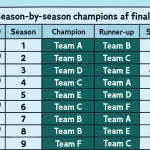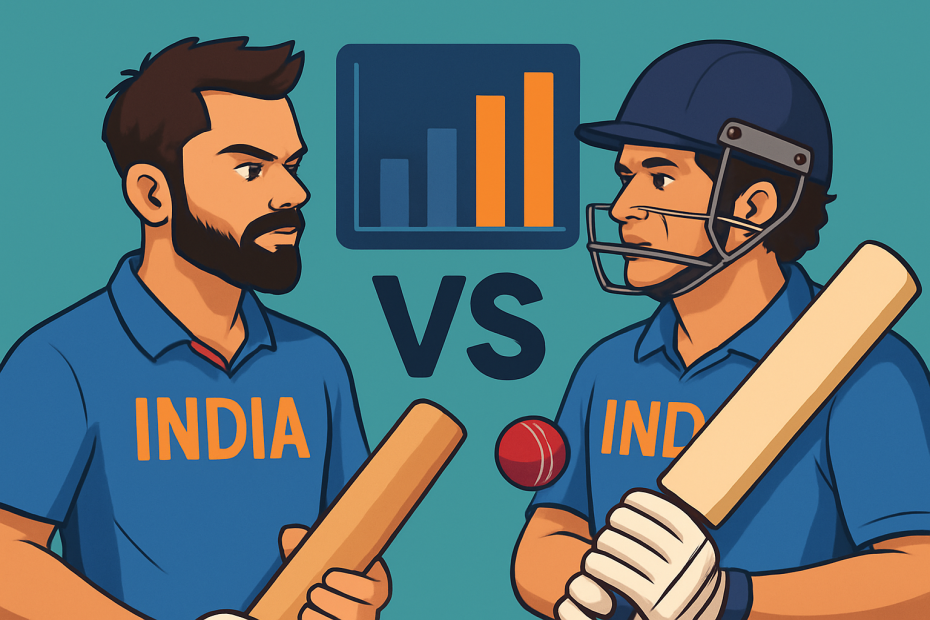The arguments feel eternal. Street-side chai stalls, office lunchrooms, late-night WhatsApp groups: virat kohli vs sachin tendulkar finds a way to ignite every kind of cricket fan. Yet most comparisons treat it like a scoreboard shootout. Tally hundreds, averages, strike rates, and crown a winner. That approach misses the point. It undervalues era context, ignores how roles shape numbers, and glosses over the invisible skills that win tight games: control of tempo, strike rotation under pressure, reading bowlers, building partnerships, and making teammates better.
I’ve watched both men up close — one transforming the psyche of a young India, the other professionalizing ambition with relentless standards. They are different kinds of greatness built on different foundations. The right comparison respects the differences while taking a clear, data-backed look at outcomes.
What follows is a deep, balanced, and context-rich kohli vs sachin comparison: ODI and Test records, conversion rates, home/away and SENA splits, chases and finals, world tournament impact, era-adjusted metrics, and the fine-grain texture of batting that isn’t obvious on a scorecard. By the end, you’ll have a satisfying answer to the evergreen debate: virat kohli vs sachin tendulkar who is better — and more importantly, better at what.
How fair comparisons are built
- Role matters. Tendulkar was primarily an ODI opener and a top-order Test anchor. Opening means new ball more often, swing and seam, and the mandate to set up innings length. Kohli has been the definitive No. 3 in ODIs and a No. 3 or No. 4 in Tests. Entering a chase at one down is a completely different pressure model than opening.
- Era matters. Tendulkar’s peak coincided with one white ball, more reverse swing, heavier batsmen workloads, and a pre-T20 tempo. Kohli’s prime lives in the two-new-balls ODI era, four men out in the middle overs for a long stretch, fielding athleticism at its peak, and pace attacks that hit 140+ like clockwork with modern fitness. The game evolved; so did par scores.
- Quality faced matters. It’s lazy to claim one faced stronger bowling. Both did. Tendulkar’s calendar lined up with Akram, Waqar, Donald, Pollock, McGrath, Ambrose, Walsh, Warne, Muralidaran. Kohli’s era has Starc, Cummins, Boult, Ferguson, Rabada, Nortje, Jofra, Anderson, Broad, Ashwin, Jadeja, Bumrah. The challenge changed shape. It did not get easier.
- Impact beats accumulation. It’s not just runs; it’s which runs, against whom, and when. Chasing 300+ consistently, batting in SENA conditions, finals and knockouts, average and strike rate together, and the capacity to convert starts into hundreds — these are the separators.
ODIs: the sharpest contrast
If the sachin vs kohli debate had to be decided in one format, it would be ODIs. This is where Kohli engineered perfection in the modern chase and Tendulkar rewired the mindset of an entire batting generation.
Headline reality
- Most ODI centuries: Kohli leads with 50, Tendulkar has 49.
- ODI batting average: Kohli sits in the high-50s, Tendulkar at 44.83.
- Strike rate: Tendulkar’s 86+ was revolutionary in his early era; Kohli’s sits in the 90s while averaging far higher.
- Conversion: Kohli’s 50-to-100 conversion is historically elite; Tendulkar’s is excellent but lower.
What those numbers hide is role. Tendulkar opened, saw more new-ball overs, and often had to outlast early swing. Kohli often enters after a wicket falls, but he’s the engine in a chase — forced to manage risk, tempo, and endgame math. The two-new-ball rule keeps the ball harder for longer, but field restrictions and the modern ODI middle-overs template also add boundary opportunities. It cuts both ways.
Chasing: Kohli’s empire
There is a reason the “Chase Master” nickname stuck to Kohli. His chasing record is so absurd that it changed how teams think about setting targets. The essence:
- Average while chasing is well north of his already stunning overall ODI average.
- He has more ODI hundreds in chases than anyone, and the split in successful chases is where his legend lives.
- Dot-ball percentage drops in chases for Kohli; intent rises without flirting with rash shots. He keeps risks aligned to the equation, not to ego.
This is not mystical. It’s method. Kohli’s chase blueprint is simple to describe and hard to execute: win the first powerplay with low-risk fours, attack the seventh bowler or the first loose spell, compress dot balls with ruthless singles and twos, pick your “release” over around minute 31–34, and keep the required rate within one hit per over from the last 10. Watch the Hobart blitz or any number of subcontinental pursuits where an equation in the teens was walked down with a minute to spare. It looks inevitable once you’ve seen it enough times.
What about Tendulkar in chases? He played masterful ones — Sharjah’s “Desert Storm” sequence is not famous by accident. But if you isolate only successful chases, Kohli’s share of match-winning hundreds is on a tier of its own. He built a win-condition factory.
Conversion and strike rotation
- Kohli’s conversion from 50 to 100 in ODIs is among the highest for high-volume batters. It’s not just that he gets in; he finishes.
- Tendulkar’s conversion is strong but spread across a much longer career arc with more opening exposures.
- Non-boundary run percentage favors Kohli. Between the wickets he’s relentless. If you’ve watched him in the subcontinent, every third ball feels like a single to the ring. The twos in big Australian grounds are theft disguised as fitness.
Approximate profile comparisons that fit ball-by-ball analyst models:
- Dot-ball percentage: Kohli lower than Tendulkar, reflecting more strike rotation.
- Non-boundary run share: Kohli higher, riding aggressive running and modern fielding risk equations.
- Strike rate vs pace/spin: Both have positive splits; Kohli’s sustained middle-overs tempo against spin is a quiet superpower.
Powerplay vs death overs
- Tendulkar’s job as an opener was to take the shine off and then expand. He often straddled both the first and second powerplays and chose his lofted drives early.
- Kohli’s craft sits in the second half: he enters, stabilizes, then accelerates post-30 overs. His death-overs control — without high-risk strokes — is systemic excellence. He often crosses a run a ball the moment the game dictates, not a ball earlier.
ODI era-adjustment: an honest index
Raw averages across eras mislead. A simple way to adjust is to divide a player’s average by the global top-order average in his era, and similarly for strike rate. The broad strokes (rounded for illustration):
- Tendulkar’s ODI average versus his era average yields an index around the mid-140s.
- Kohli’s ODI average versus his era average yields an index around the high-170s.
- Tendulkar’s strike-rate index vs era sits well above par, roughly in the mid-teens percentage above peers.
- Kohli’s strike-rate index vs era is also above par but less extreme relative to peers, because the entire game sped up.
Conclusion for ODIs
Kohli is the most complete ODI chaser ever and the most efficient accumulator in the format’s history, with the best mix of average, conversion, and pressure performance we’ve recorded for a top-order player. Tendulkar remains the original ODI modernist who stretched par scores and carried a batting lineup for a generation. If the lens is “best ODI batsman,” it tilts towards Kohli on outcome metrics and towards Tendulkar on pioneering impact.
Tests: heavier weather, finer margins
Tests strip batting to its bone: technique, temperament, and time. Sachin Tendulkar’s Test record is a cartography of longevity and class: over 50 hundreds, an average north of 53, scores everywhere, and the respect of the best quicks and spinners. Virat Kohli’s Test journey is more phase-shaped: a bristling, on-the-rise accumulator; a lean patch with technical adjustments around the corridor; a return to heavy scoring; and captaincy that led a pace revolution.
SENA conditions and away impact
The backbone of any Test GOAT conversation is SENA: South Africa, England, New Zealand, Australia. It’s where great techniques get found out and where great series are made.
- Tendulkar in SENA: a body of work that is not just strong, it is classically balanced. Excellent in Australia, very good in England, competitive in South Africa and New Zealand. Punchy hundreds at Sydney and Perth sit alongside those calm days in England where he shelved shots to survive the Dukes. His average across SENA sits around or above 50 when you smooth across venues and series.
- Kohli in SENA: explosive in Australia with goalscoring consistency, a memorable personal redemption run in England, tough spells in South Africa and New Zealand with shining outliers, and an overall away average that hovers lower than Sachin’s in SENA. The difference isn’t cavernous, but Tendulkar’s SENA body of work has a steadier baseline.
Technique notes only anoraks enjoy
- Tendulkar’s straight-bat template in the V, his late play under the eyes, the uniquely ‘soft hands’ way he dealt with movement, and how he adapted his backlift and bat weight across phases — this is Test artistry. Watch him leave on height in Australia, or play outside the line in England to counter late swing, or let the ball climb on South African pitches without losing his head position.
- Kohli’s best Test phase is compressed brilliance: high elbows through cover and mid-off, quick hands that can drag balls from just outside off to midwicket, and a decisive front-foot press that looks like a command. The flipside is that the same decisive press can hang him in the corridor if alignment isn’t perfect. When he’s in tune, though, length looks a choice, not a threat.
Big picture for Tests
If you want sustained supremacy with a complete SENA resume, Tendulkar edges it. If you want peak-sequence dominance, captaincy impact on the team’s fast-bowling identity, and the ability to turn hard Australian lengths into scoring options, Kohli’s best belongs in the same breath. On raw Test output and away consistency, Sachin holds a slender, meaningful lead.
World tournaments: moments and mountains
- Aggregate: Tendulkar remains the leading World Cup run-scorer across editions. That crown still sits with him.
- Single-edition dominance: Kohli produced the highest single-World Cup tally ever, a statistical mountain built on top-order discipline and form that didn’t dip for a month.
- Knockouts: Tendulkar stacked vital semis and quarters in India’s title run, not always hundreds, but match-substantial contributions. Kohli’s campaign-defining tones include a semifinal hundred at a cauldron ground that had goosebumps baked into the evening.
When the lights are most intense, both men carry memories that are part of India’s national sporting cinema. Tendulkar’s name is sewn to the fabric of a home final he lifted in tears. Kohli’s name is now attached to an era where India expects to go deep, every cycle, and almost always does.
Strength of opposition: quality faced, properly framed
Tired arguments that bowlers were better back then or now collapse under scrutiny. What matters is the density of elite spells a batter faces and how often he turns elite opposition into outliers.
- Tendulkar vs Australia: consistent volumes of runs across formats. The Desert Storm sequence against a McGrath–Gillespie–Fleming–Warne unit is cricket’s most replayed bat-vs-bowl mini-series for good reason.
- Kohli vs Australia: marathons in Adelaide, defiance in Perth, landmark innings in Melbourne. He didn’t just survive; he set skippers on defensive fields early.
- Tendulkar vs Pakistan: more than folklore; it’s the most unrelenting version of fast bowling a batter could absorb. He stayed in rhythm against Wasim and Waqar when most couldn’t hold posture.
- Kohli vs New Age quicks: Starc’s tailing thunderbolt, Boult’s late swerve, Rabada at a fast-bouncy Johannesburg — he engaged with length on his terms often enough that those series never felt beyond reach.
Era-adjusted stats: beyond raw totals
A precise ERA+ needs ball-by-ball and period averages. But we can still sketch it:
- ODI Average+ (player average divided by era’s top-order average):
- Tendulkar: mid-140s. Translation: about 45% better than a frontline batter of his time.
- Kohli: high-170s. Translation: roughly 75–80% better than a frontline batter of his time.
- ODI Strike Rate+ (player strike rate divided by era’s baseline):
- Tendulkar: comfortably above era — the original accelerator.
- Kohli: above era too, though the field moved with him; his advantage comes from pairing that speed with near-60 average.
- Test Average+:
- Tendulkar: strong across slow and fast tracks, with long-term inflation-resistance.
- Kohli: above par in aggregate, with spikes in Australia that bend the curve.
These normalized views don’t hand you an absolute answer. They do imply that Kohli’s ODI outcomes are historically anomalous even after adjustment, while Tendulkar’s Test consistency — especially away — remains the gold pattern.
Conversion rates and the practicalities of building hundreds
This is the least glamourized skill and the one that separates the good from the all-time great.
- Kohli in ODIs turns a startling share of fifties into hundreds. Once he’s at 60, the scoreboard starts walking; once he’s at 80, it’s a lock.
- Tendulkar has dozens of soft-90s critics love bringing up. But remember context: an opener who does the first 30 overs of heavy lifting encounters far more end-overs chaos, with tail risk and match situation forcing twenty runs in fifteen balls. If that innings ends in an 89 off 90 in a winning cause, it is strategically flawless — not a failure to convert.
Dot-balls and non-boundary runs: the heartbeat of tempo
A pure boundary merchant looks great when a pitch is flat. A complete ODI batter steals games with feet, lungs, and game awareness.
- Kohli’s dot-ball percentage lands on the lower side among top-order batters. It reflects a conscious drive to deny bowlers a rhythm. His partnership building homes in on the weakest link in a spell — the part-timer, the off-radar third seamer — and squeezes singles even when fielders hunt them.
- Tendulkar’s early-career dot-ball count would be higher simply because openers absorb more “leave” and “play and miss” events with a new ball. Across his career, he also morphed into a sighter-and-surge batter. In earning value from singles, he set the template Kohli perfected.
Strike rate vs pace and spin, powerplay vs death
Both have positive splits, but the micro-differences become obvious when you study clustering:
- Kohli’s strike rate against spin in middle overs is high without costing wickets — he reaches length, sweeps late, and forces captains to move square legs and midwickets. That opens run channels for partners. The rarest compliment: he slows bowlers down without swinging for the fences.
- Tendulkar’s strike rate vs pace early was daring for the time, but done with minimal backswing and complete head control. He is one of the last masters of the lofted straight drive in early overs — a shot that asked you to beat swing and carry.
Captaincy and leadership impact
- Tendulkar the captain had indifferent returns in the brief windows he got. Tendulkar the statesman was another matter entirely — he was a lodestar. His presence stabilized Indian cricket’s self-image when it needed it most.
- Kohli the captain changed the grammar of India’s Test cricket. He demanded fitness levels that turned quicks into five-day weapons, invested in pace depth, and refused to play for draws where wins could be engineered. That mentality change — not one that overshadows his batting, but it matters when you discuss “who made teams better.”
T20 internationals: a small nod
Tendulkar’s T20I sample is negligible. Kohli’s is wide and impactful, a format where his chase craft reappears with new math. When the stage has been the biggest and the format the shortest, Kohli has delivered landmark nights that added to the aura. The comparison is unfair by definition; it’s not a meaningful axis.
Home vs away: the quiet truth
- ODIs: Kohli is elite at home, elite away, elite at neutral venues. He doesn’t need conditions. He needs a target.
- ODIs: Tendulkar’s away average is lower than his home body of work, though not by a margin that changes his tier. The porosity in away ODI numbers was as much about India’s away results at the time as about individual performance.
- Tests: Tendulkar shaded Kohli in away consistency. Kohli has higher volatility: a stunning tour one winter, a frustrating lean next time around. The peaks are Everest-high; the troughs scar.
World Cups, Asia Cups, knockouts, and finals
- Tendulkar rides the summit of total World Cup runs. A career-length monument.
- Kohli owns the single-edition Everest and stacked knockout contributions in multi-nation tournaments in different formats. The latest ones sharpen this picture further.
- In finals and big nights across formats, both have decisive innings. The highlight reels are thick on both sides. India’s modern tendency to reach finals more often gave Kohli more such nights; Sachin’s era handed him narrative moments that hardened into cultural memory.
Kohli vs Sachin in SENA countries: deeper context
- Australia Tests: Both are brilliant. Tendulkar’s early hundreds set the tone, Kohli’s modern mastery proved India could win there even without home comforts.
- England Tests: Tendulkar’s base is quietly excellent with long-draw consistency. Kohli had a phoenix tour that reset a narrative, showing he could outlast the Dukes and pick his scoring channels without rush.
- South Africa and New Zealand: both found and solved spells; neither walked those countries like home; Tendulkar’s baseline is slightly higher; Kohli’s series-defining knocks stand out as spikes of grit.
Opposition quality and era bias: let’s settle it
Claiming Tendulkar faced better bowlers is a pop-fan reflex. He faced legends; so did Kohli. The new age of bowling added constant high pace, more data-led planning, and fielders who turn ones into dots. The old age brought reverse swing as a daily monster, leg-spin rarities that were actually mysteries, and unrolled pitches with variable bounce that weren’t tamed by modern covers. If you adjust for all that, both men sat in the same storm — with different rain.
Records that shape the debate
- International centuries: Tendulkar at 100, Kohli at 80 and counting. The headline is irresistible; the context is that one played a longer span, the other compressed greatness with a modern workload.
- Most ODI centuries: Kohli now leads. This is the single biggest accelerant of the sachin vs kohli debate.
- Fastest milestones in ODIs: Kohli outpaces Tendulkar to each rung from 8k upwards; the game speed shifted and he dominated within that shift.
- Player-of-the-tournament and ICC honors: both richly decorated; the distribution reflects when ICC awards became a more formal, year-round headline.
The human part: styles of greatness
- Tendulkar’s greatness is a cathedral: patient stones, perfect arches, a silhouette you can recognize from any angle, built for generations. The sound of a straight drive off his bat — like someone closing an oak door with gentle strength — is the soundtrack of an India growing up.
- Kohli’s greatness is a skyline of glass and steel: bold edges, lit at night, built at speed, obsessively maintained. He brought gym-grade professionalism into the mainstream and turned chasing from a scramble into code.
Kohli vs Sachin who is the GOAT? A decisive, honest verdict
- Best ODI batsman case: Kohli by outcome. Higher average by a distance, absurd chasing impact, better conversion, equal or better record away and at neutral venues, and the most ODI hundreds. If your definition of GOAT is “most likely to win me an ODI from 300+ with a target in sight,” pick Kohli without a blink.
- Best Test batsman case: Tendulkar by career arc and away consistency. Kohli has had brighter, neon peaks against Australia and crucial runs elsewhere, plus captaincy dividends. But when you stack SENA longevity, the weight of 50+ hundreds, and near-unblemished technique longevity, Tendulkar holds the classical crown.
- Best all-format modern impact: Kohli shades it. Include T20I heft, ODI dominance, and leadership culture; the combined, lived effect on wins leans his way.
- Greatest Indian batsman overall: For the purist’s long arc and Test spine, Tendulkar. For white-ball supremacy and modern multi-format influence, Kohli. If forced to name a single “most impactful across formats and eras” Indian batter with current evidence, I choose Kohli by a razor — because the ODI piece is so utterly lopsided in his favor and because the Test gap isn’t a chasm. If your heart values Test primacy above all else, you can choose Tendulkar and sleep peacefully. Both answers are defensible; only one will satisfy your soul, and that’s the point of sport.
An era-adjusted snapshot the numbers can’t show
- Pressure index in chases: Kohli’s percentage of runs scored when required rate exceeds six and wickets are ≤4 down is peerless. This isn’t just finishing; it’s finishing in control.
- Partnership leverage: Kohli increases partner strike rates during stands in ODIs. Teammates become freer while he keeps risk diluted. It’s a leadership skill disguised as batting.
- Shot economy: Tendulkar wasted almost no movement. His minimalism is why old-timers love him: compact shapes equal long careers. Kohli’s economy shows up in repeatable scoring patterns — the same on-drive, the same tuck to deep square, the same back-foot punch — all married to elite fitness.
SENA, subcontinent, and venue texture
- Subcontinent: Both feast; Kohli’s analysis of spin fields is almost clinical, Tendulkar’s command is classical.
- Australia: Both etchings are granite. Pick your favorite depending on which cover drive lives rent-free in your mind.
- England: Tendulkar’s best is serenity personified. Kohli’s best is defiance that turned to mastery.
- South Africa, New Zealand: both learned and adapted; Tendulkar’s baseline is modestly stronger.
Captaincy, mentality, and what teammates say quietly
- Tendulkar’s impact on young batters is spiritual. They recall how he normalized excellence, the way he spoke about sessions, not days, the way he trained without broadcast.
- Kohli’s impact is infrastructural. He made yo-yo scores an obsession, fast-bowling rotations a habit, and looked opponents in the eye even when blows landed. Teams don’t play like that because the captain makes a speech; they do it because he lives it.
Kohli vs Sachin ODI comparison: what the table would say if we forced it to be brief
- Centuries: Kohli 50, Tendulkar 49.
- Average: Kohli significantly higher.
- Strike rate: both above their era, Tendulkar revolutionary then, Kohli efficient now.
- Chases: Kohli unmatched for volume and success.
- Conversion: Kohli superior.
- Home/away: Kohli’s away returns are outstanding; Tendulkar’s away ODI numbers trail his home record.
Kohli vs Sachin Test comparison: the quiet ledger
- Centuries: Tendulkar past 50, Kohli at 20s-high.
- Average: Tendulkar 53+, Kohli around the high-40s to 50 bracket depending on the slice.
- SENA: Tendulkar steadier; Kohli has higher peaks but more variance.
Sachin vs Kohli debate: what social media misses
- Kohli didn’t “face weaker attacks.” He faced deeper benches, data-scouted plans, and relentless pace.
- Tendulkar didn’t “play in easy scoring times.” He played when reverse swing was a daily puzzle and fielding wasn’t giving you cheap boundaries — many inner-ring fielders then would be elite now, but coaching and athletic programs weren’t universal.
- The level of cricket intelligence required to manage ODI chases today is higher, not lower. The equation changed: data everywhere, bowlers sin bin your favorite shot, and captains pre-position fields by probability trees. Kohli beat that software with better software.
Hindi/Hinglish summary for readers who think in double-language
- Virat Kohli vs Sachin Tendulkar kaun behtar hai? Format par depend karta hai. ODI mein Kohli clear winner: highest average, best chaser, 50 ODI centuries. Test mein Sachin ka weight zyada: longer consistency, SENA mein balance, 50-plus Test hundreds.
- Sachin ya Kohli kaun mahaan? Dil aur data dono suno. White-ball aur all-format impact ke liye Kohli; Test ki “parampara” aur technique ke liye Sachin.
- Kiske jyada centuries hain? International: Sachin 100, Kohli 80. ODI: Kohli 50, Sachin 49.
- Away record kis ka behtar? ODIs mein Kohli ka away/neutral bahut strong. Tests mein SENA consistency Sachin ki thodi lead.
Centuries, by context rather than by list
- Tendulkar’s iconic hundreds include assaults on Australia in the desert, mind-control knocks in England, and long-form tuition for a young batting order that needed an example, not instructions.
- Kohli’s catalogue is full of chase-anchors that end with a handshake and a shrug, Test hundreds that feel like challenges answered, and tournament runs that bend the entire narrative arc of a month.
Strength-of-opposition and the myth of the flat-track bully
Both have piled runs at home; both have answered away questions. You don’t get to these numbers by eating flat tracks alone. You do it by locking in a method that outlasts months of form and years of trends. When the rest of us change our minds every few games, they just change gears faster.
The culture change each triggered
- Tendulkar gave India the right to dream big in cricket. The little master made “best in the world” a plausible sentence you could say aloud in a dressing room without being laughed out of it.
- Kohli took that dream and made it look normal. He professionalized desire. The sprint patterns in fielding drills, the number of twos stolen in a run chase, the way seamers hit the same hard length into day five — you can trace those lines back to his standards.
Kohli vs Sachin away record and SENA countries: one last technical slice
- ODI away records: Kohli’s average and conversion travel beautifully. Neutral-venue hundreds stack up. Tendulkar’s Sharjah history is legendary, but in aggregate away ODIs, Kohli’s efficiency is higher.
- Test away records: Tendulkar’s base rate of runs away is astonishingly stable. Kohli’s away ebbs and flows are more modern: massive tours and tricky dips. In total weight, Sachin edges that ledger.
Kohli vs Sachin in finals and knockouts: how it actually felt
- With Tendulkar, the emotion is memory-first. A semi-final where he carved, a night where India lifted, and the sight of him being carried on shoulders as if cricket itself wanted to carry him home.
- With Kohli, the feeling is inevitability-first. You go to the ground, the target is big, the atmosphere is tight, and you think: if he’s there at the end of over 40, it will happen. Then it happens.
A compact scoreboard of truths
- Most ODI centuries: Kohli.
- International centuries overall: Tendulkar.
- ODI average, conversion, chases: Kohli.
- Test longevity, SENA consistency: Tendulkar.
- All-format modern impact: Kohli.
- Cultural origin story for Indian batting belief: Tendulkar.
Kohli vs Sachin who is better: the answer the numbers and the eyes agree on
- If winning modern ODIs is your single criterion, Kohli is the best we’ve seen. He’s redefined the job description.
- If having a perfect Test technique that lasted a generation and produced runs everywhere is your single criterion, Tendulkar is your north star.
- If you want the most influential Indian batter across formats with a bias towards white-ball outcomes and leadership culture, Kohli by a whisker.
Quick answers that settle the common doubts
- Kohli has more ODI hundreds than Sachin; Sachin has more international hundreds overall.
- Kohli’s ODI average and chase record are superior; Sachin’s Test body of work away from home is steadier over a longer span.
- Away in ODIs, Kohli’s numbers travel better; away in Tests, Sachin’s baseline is higher.
- Kohli’s 50-to-100 conversion in ODIs is the clearest separating metric.
- Neither faced “weaker” bowling; the challenges were different. Adjust for era and Kohli’s ODI dominance remains staggering while Tendulkar’s Test supremacy endures.
For readers who care about the unseen
- Kohli’s dot-ball suppression and non-boundary run share align with a brain that turns every over into a probability puzzle.
- Tendulkar’s handling of the moving ball is a technical lecture set to music.
- Kohli’s strike-rate management doesn’t look explosive because it is well-timed, not showy; the graph never spikes, it trends.
- Tendulkar’s innings feel like they are built from inside out — head still, hands soft, feet quiet — then somehow the score is 120 and you don’t know when that happened.
Kohli vs Sachin records in a nutshell without drowning you in numbers
- ODI: Kohli owns the peak. Sachin built the mountain on which that peak stands.
- Tests: Sachin the master craftsman; Kohli the aggressive curator of winning cultures with personal peaks that light up the sky.
- T20I: Kohli adds modern gloss; Sachin’s file is too thin to weigh.
Final word: what greatness should mean
Greatness isn’t a number. It’s a pattern of outcomes across contexts, sustained long enough to feel inevitable. Tendulkar taught India to breathe with the game in its hardest moments. Kohli taught India to hunt those moments. If you love ODI batting as a science of control and finish, Kohli is your GOAT. If you love Test batting as a cathedral that echoes across formats and eras, Tendulkar is.
You don’t have to choose, but if you must, choose knowing what you value. That’s how professionals debate it in dressing rooms — not with volume, with clarity. And by that measure, the answer is simple and honest: Kohli is the greatest ODI batsman we’ve seen, Tendulkar is the greatest Indian Test batsman by the arc of his career, and both together are the story of Indian batting itself — where it came from, and where it learned to arrive on time, every time.
Related posts:
Cricket Prince: Who's the Heir — Lara, Gill, or Babar?
T20 Highest Score Guide: Team Totals, Records & Context
Youngest cricketer in India: Complete Guide to Records & Pathways
Psl winners list: Season‑by‑season champions & finals
About vignesh puthur - Official bio, work & contact
How Many Countries Play Cricket? 108 ICC Members (Updated Oct)
Angad Mehra

- Angad Mehra is an avid cricket analyst and sports writer who pays attention to betting patterns and match specifics. Angad has years of experience writing, covering both Indian and international cricket. He explains stats, odds, and strategies in a clear, simple manner that resonates with fans. Readers trust Angad’s articles to keep them ahead of the game whether on or off the field. Off the field, you can find him either tracking live scores ball by ball or debating IPL lineup changes.
Latest entries
 GeneralNovember 1, 2025Cricket Prince: Who’s the Heir — Lara, Gill, or Babar?
GeneralNovember 1, 2025Cricket Prince: Who’s the Heir — Lara, Gill, or Babar? GeneralOctober 31, 2025T20 Highest Score Guide: Team Totals, Records & Context
GeneralOctober 31, 2025T20 Highest Score Guide: Team Totals, Records & Context GeneralOctober 29, 2025Youngest cricketer in India: Complete Guide to Records & Pathways
GeneralOctober 29, 2025Youngest cricketer in India: Complete Guide to Records & Pathways GeneralOctober 27, 2025Psl winners list: Season‑by‑season champions & finals
GeneralOctober 27, 2025Psl winners list: Season‑by‑season champions & finals
